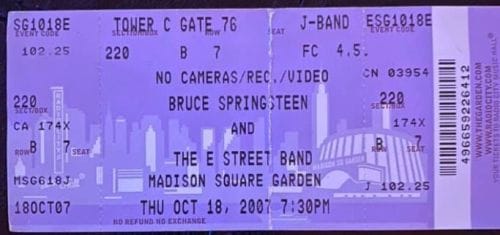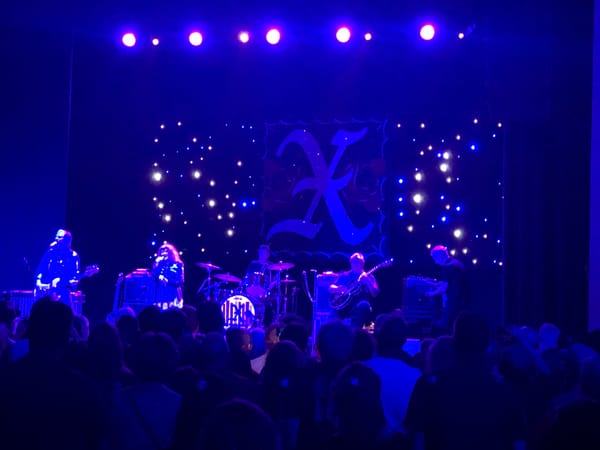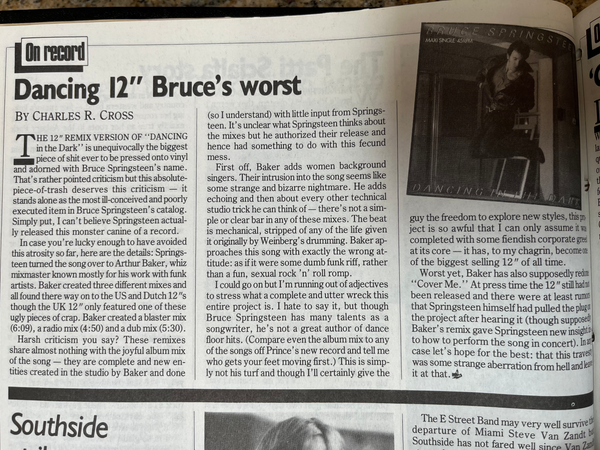Bruce Springsteen: Only The Strong Survive
play it, Steve
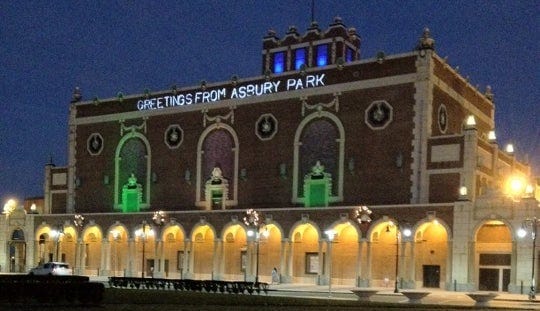
In 2003, Bruce Springsteen was still doing Christmas shows in what was still a deserted Asbury Park. If you went to AP back in the pre-gentrification era, you probably remember that feeling of stepping into a time machine. So when the special guest that year was Sam Moore, it definitely added to that whole aura of ye olden times you felt every time you drove down the Garden State Parkway, got off at exit 102, and then drove straight down Asbury Avenue until it turned left along the boardwalk, and parked near the Pony or Convention Hall.
There is so much about those shows that was special, but the main event was Sam Moore’s appearance. It was orchestrated just like it was out of a rhythm and blues revue of the 60’s, and there is a reason those shows were set up the way they were. The Alliance Singers (Lisa Lowell, Soozie Tyrell, Michelle Moore, others) come out, take their places, and Bruce cues them to start. They begin singing the refrain of “Hold On, I’m Comin’” while Bruce goes full “Star Time,” because who wouldn’t in this situation?
“We have with us tonight, one of the greatest soul singers on the planet Earth! So hold on to glasses, grab hold of your asses, and put your hands together, and put your arms together for Sam Moore!”
That’s when the band and the horns come in with that unmistakable riff, that refrain you can hum in your sleep. As soon as Bruce sees Sam making his way across the stage there’s a flurry of fanboys doing the “We’re not worthy” bow. Sam looks around, lets the band vamp. In the video, you can see the moment where Sam is ready to go and Stevie raises his arm in the air to cue the band. And then we’re off, and it is the kind of rock and roll moment you dream about. (At least I do.)
eternally grateful this exists.
Friends, I have seen Screamin’ Jay Hawkins emerge from a coffin; I have seen Solomon Burke come out wearing a crown and a cape, carrying a scepter, and sitting on a throne. This moment beat them all, and it’s unlikely I’ll ever see anything like this again. It still gives me goosebumps.
Old school. Every single musician on that stage cut their musical teeth on this music, hearing it on the radio, buying the singles, learning it, playing it, loving it, arguing about it, performing it night after night at teen dance clubs and VFW halls and supermarket openings and senior proms, anywhere, they could play and get paid (but mostly play). Just, like, the unbridled joy on people’s faces on that stage was overwhelming. Their love for this music and their personal connection and professional history with it, was rolling off the stage in waves. Watching Bruce with Sam, Bruce taking the Dave Prater lines, Sam yelling “Play it, Steve” during “Soul Man,” grinning at Steve Van Zandt as he did, or the moment when they segued into Otis’ “Sad Song,” that moment of collective wow and shared acknowledgement of, we know what this is, we know who this was, this is important, to us and to history.
Bruce told stories during the show, about how he used to go to the Satellite Lounge outside of Fort Dix and watch Sam & Dave, specifically, referencing how he used to go and study —“I didn’t watch him, I studied him” -- and how everything you saw in songs like “Mary’s Place” he learned from studying Sam, that he considered him to be one of the great band arrangers and band leaders -- “It’s a lost art” -- watched Sam lead a band in order to learn how you did that. There was also that moment during “So Young and In Love” where he took off his jacket, slung it over his shoulder, thanking Jackie Wilson. (Seriously, I died. This is my ghost writing this.)
This wasn’t a regular Bruce Springsteen concert where someone walked on and sang a song or two with them; this wasn’t even the RRHOF 25th Anniversary show that had Sam *and* Darlene Love (which, don’t get me wrong, was also pretty fucking great). It was the force of all of these elements together letting you feel what it was like back in the day from a rock and roll perspective. You didn’t get to go to the Brooklyn Paramount or the Fox? You never saw a Motortown Revue? Here you go, a little stardust for ya. And it was stardust, because everyone on that stage not only was a talented musician, they had an emotional connection to the music, they had listened to and played those songs over and over, and so you can feel some of what they are feeling.
Another element worth noting from the ‘03 Christmas shows is how careful Bruce was with his vocals. He didn’t over-sing and he didn’t over-emote, which are two elements he can fall into when he’s trying to use his soul singer voice. He is very proud of that particular style of vocals -- he wants to sing like his idols! -- but he doesn’t always recognize when he is overdoing it, and he doesn’t always have someone who can, or will, tell him to dial it back. It is a skill, and if you are not always singing like that, you might need to re-orient yourself.
All of the above is why Springsteen’s new album, his soul covers record Only The Strong Survive, should have been absolutely incredible. He has the chops, he has the knowledge and the genuine emotion and affection, he can snap his fingers and the most talented musicians in the world who also vibe with this would be at his service. It would be a breeze, he’d be hanging out with old friends, they’d argue about their favorite songs, Bruce would win and only later realize that Stevie made him feel like he won the argument when he, Steve Van Zandt actually did.
Even if he decided he wanted to bring in musicians who aren’t yet members of AARP there is no shortage and not one person would have said “no” to Bruce Springsteen. There are a million ways that this record could have been the coolest fucking thing. It could have also just been an incredibly well executed soul covers record, with great musicians and performances, and Bruce could live out his Wall of Sound or Studio A or (either Stax or Motown) dreams. Instead this is a record that I cannot listen to either as a Springsteen fan or a soul music fan and historian, because it is not executed well. Worst of all, it feels completely inauthentic. It will, however, be pleasant enough for most people.
At this stage of his career, he’s definitely doing the thing that he refers to as “getting all summational,” something he does at the end of tours but it makes sense that after seven years working on his autobiography, and then the Broadway show, followed by and Western Stars and Letter to You —while both original material, they absolutely touched on those formative years and musical influences. Bruce has certainly earned the right to get loose and have some fun with his friends, but he is not doing that here, because none of the people you would expect to be on a record of soul covers with Bruce Springsteen are anywhere to be found (with a few exceptions with the horn section and the backing vox) —in fact, there is no actual band involved, at all. Somehow Bruce Springsteen thought this overly bright, dynamically insubstantial, and emotionally unfulfilling selection of soul music was something that needed to be publicly released and presented as part of his legacy.
As we’ve already established, Bruce is very enamored of his soul voice, but it’s not how he naturally sings, so he can overdo it if he’s not careful. He’s careful, with great results, on “The Sun Ain’t Gonna Shine Anymore,” and while the arrangement doesn’t wow, at least it doesn’t distract from the vocal performance. He also does a phenomenal job with “I Wish It Would Rain,” which man, that song walks such a delicate line between hope and despair, and he hits the mark with pathos and precision. Again, the arrangement isn’t great; it’s doing too much for this song, and if you are going to rearrange the song, then put this vocal front and center. The songs with Sam Moore sound great, you can’t even really tell they did it remotely, and that has a lot to do with the fact that they are drawing on mutual respect and a long relationship together. I’m so glad it’s on record.
But that’s not the case with the rest of the album. “Nightshift” is an example of over-emoting, or maybe it’s that incredibly rare instance of Bruce Springsteen incorrectly reading the emotional tone of a song, but the delivery feels awkward and uncomfortable. He took Aretha’s “Don’t Play That Song (He Lied)” and turned it into a party song -- yes, Aretha’s version also swings, but the parenthetical in the title is not a joke. This song is meant to be defiant or at the very least, insistent. The chorus is, literally, “Oh darling, you lied, you know that you lied.” When Aretha sings those lines, I get chills. But Bruce bops through this song like there’s nothing going on and starts it with a fraternity rock-era bit of crowd noise and invocation of HEY GOOD TIMES. There is no way I know anything about this music that Bruce Springsteen does not, which is what makes this even more of a crime against nature.
Then there’s the closing number, ”Someday We’ll Be Together,” originally performed by none other than Diana Ross & the Supremes, at that point where Diana was heading into her solo era and leaving the Supremes behind, it’s such a poignant track for that reason. Diana’s inflection, tone, and control are singular, and this is why no one covers those songs. It is so clear that the arrangement and performance on OTSS is meant to exactly mimic the original because that is what this record is, and it’s certainly done with outstanding attention to detail, but what it is completely missing is that exquisite continuity of emotion that Motown were stellar at figuring out how to create and capture, and without that, there’s no point in doing the song.
But the worst choice on this record, in terms of mis-match of material and vibe and everything else is Jackie Shane’s “Any Other Way.” It is with complete and total confidence that I affirm that Bruce Springsteen can write, perform, and deliver songs from a variety of viewpoints and personas and characters, and he absolutely could have offered a powerful or at least interesting interpretation of “Any Other Way.” You elide her entire history by neutering this song in this fashion, turning it into a bouncy romp.
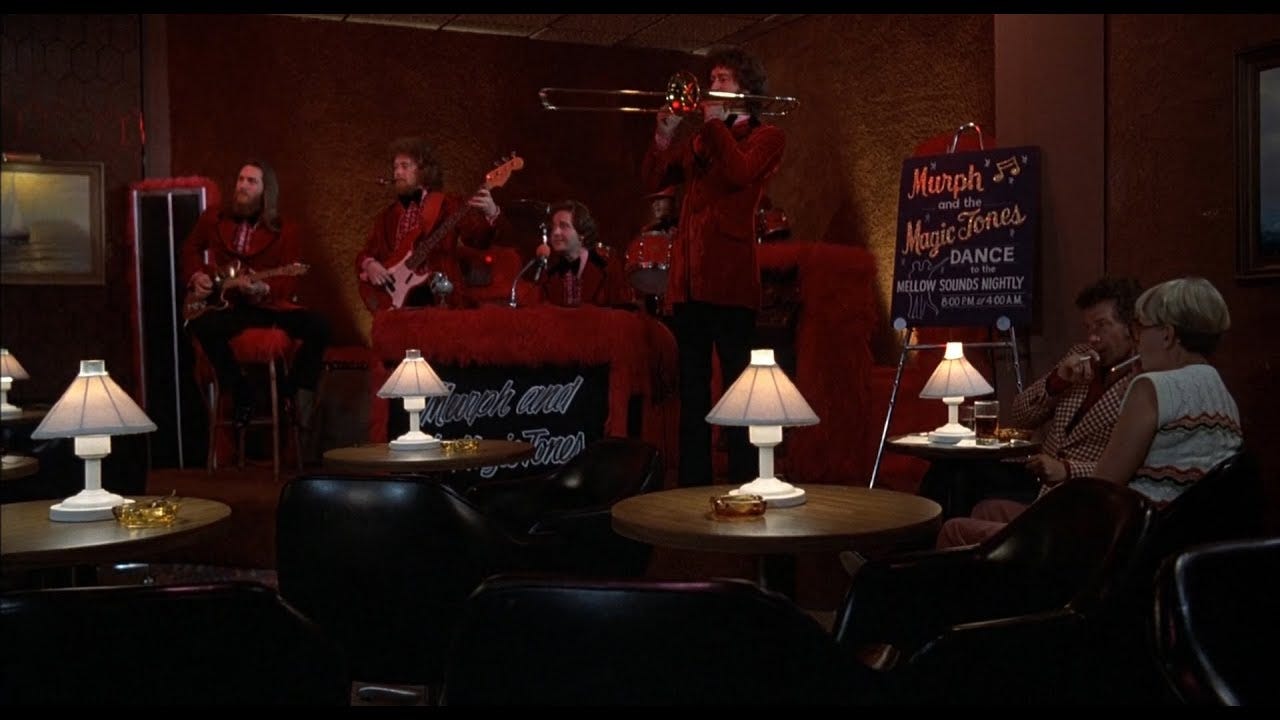
A few songs into my first listen to the record, I texted a friend, “It’s Murph & the Magic Tones.” Now, Steve Cropper and Duck Dunn (and other outstanding musicians) were in the Magic Tones, so it’s not exactly analogous, but the purple velour and hotel lounge band blandness of Murph & his pals were because they needed to cater to the lowest common denominator and so they needed to make everything smooth and pleasant and feature-less, and that is what has somehow happened here on this Bruce Springsteen record in regards to the instrumentation, arrangements, and production. It sounds like Bruce is singing over a karaoke backing track, because there is simply no depth. Everything is colored the same bright and inoffensive hue no matter what. We will be hearing this in grocery stores and elevators for the rest of our lives.
There are a lot of very talented string players on this record; they are insanely qualified as classical musicians, but to the best of my knowledge and research, have no background playing rock and roll, but it’s not their fault that they’re shoved in your face at the top of the mix. In defense of the horn section: they’re great. They’re always great. The production of the horn section, however, is inelegant and flat. I do not understand how the same person who threw the first mix of Born to Run into a swimming pool, or who remixed the guitar solo on “Prove It All Night” after the tapes were already at the pressing plant, or the guy we saw in that Barry Rebo footage complaining that you can hear Max’s drum stick, thought this record met his standards.
I also cannot understand why, when Sugar Miami Steve Van Zandt, the man who sang horn charts to the Brecker Brothers and played the oldies circuit with the Dovells, is one of your oldest friends, that he is not the first phone call you make for this project. Or Garry Tallent, who, with a guy named Southside Johnny, owns one of the largest collections of rnb 78s in the world. (ALSO: SOUTHSIDE JOHNNY LYON IS STILL ALIVE AND LIVING IN OCEAN GROVE) And, you know, maybe he did, and maybe Steve and everyone else involved said “nah, use someone else,” and even if this is true, I would have rather that he found a local cover band that he liked that covered soul music and gave them the gig, because they would have played their hearts out. However, none of that would have solved the problem with the production and arrangement, and the only solution for that is, use someone else. But the person who signs off on that is the one who has his name on the front cover.
Here’s the thing, though: he’s smart, because he knows no one will care, that he can do whatever he wants and people will embrace it wholeheartedly. Do you remember that 90’s movie, The Commitments? It was a bunch of Irish kids who form a soul band. (Glen Hansard was in it!) Anyway, the soundtrack was super-popular, but when I made a tape of the originals for people who adored the movie, they didn’t like it and they didn’t care. They liked the versions of the songs they heard in the movie. Only The Strong Survive is for those people, and there are more of them than there are of people like me.
Years ago, Dave Marsh once told me, “You are the toughest critic in the fanbase that still gets what he’s trying to do.” It’s my job to pay attention and hold Bruce Springsteen accountable, and so, here we are.

